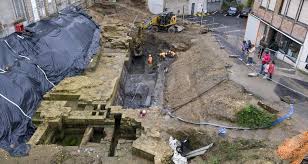Centuries ago, a castle was abandoned in France. Now, its remains have been uncovered about 10 feet beneath a former hotel in Vannes. The Château de l’Hermine castle is in remarkably good shape. Archaeologists have even discovered a plumbing system, staircases, countless artifacts, and a moat.
Rediscovering The Château De L’Hermine Castle
According to a statement from the National Institute of Preventive Archaeological Research (INRAP), archaeologists have known since at least 2021 that the bones of the medieval Château de l’Hermine still existed beneath the 18th-century mansion built on the same grounds. In 2023, they began to examine the site in earnest ahead of the construction of the Museum of Fine Arts of the City of Vannes — and found the 600-year-old castle in remarkably good shape.
Under a thick embankment [eight to 13 feet], archaeologists unexpectedly uncovered the ground floor of an imposing building which they excavated over a meter of elevation and which corresponds to… the ducal residence,” INRAP explained. “A central passage connects the north door, built in the city side facade, to another door framed by two large towers sitting on the city wall and identified on old plans, overlooking the exterior moat.”
The ground floor is around 137 feet long and 55 feet wide and has sturdy walls that are nearly 20 feet thick. Archaeologists have discovered remains of a moat, several staircases — including a “ceremonial staircase” — and drainage pipes from the castle’s latrines, as well as evidence that a mill was built into the castle itself, taking advantage of the nearby Marle River.
In addition, archaeologists also found a number of items that were left behind by the castle’s residents. These include keys, clothing, shoe buckles, coins, cooking utensils like frying pans, bowls, and even jewelry.
The castle — and the items found inside — are a compelling reminder of the Château de l’Hermine’s century-long history.
The Fascinating History Of The Medieval Castle
According to INRAP, the story of Château de l’Hermine begins with Jean IV, the Duke of Brittany. In 1365, he inherited the Duchy of Brittany. In 1381, he began to build fortresses “in order to assert his power,” including in Vannes.
“The construction of the building took place in a single phase, which demonstrates the importance of the financial and human resources used,” the INRAP statement notes. “The remains indicate that Jean IV knew how to surround himself with the best engineers and craftsmen of the time.”
The Château de l’Hermine became a stronghold and one of Jean IV’s favorite residences. But within a century, the castle was abandoned.
INRAP reports that the castle was deserted by François II in 1470, who preferred the nearby city of Nantes. Over the years, the castle was neglected and was abandoned between the 17th and 18th centuries.
According to the Vannes Mayor’s Office, the castle was purchased in 1784. Its ruined towers were destroyed, and a mansion was built in its place. It was later transformed into a hotel with a restaurant called the Hôtel Lagorce. After this business shut down in 1803, the French government bought the building. It has since been used for different purposes, from a law school to the Public Treasury office.
Today, it’s an exhibition venue.
The story of the Château de l’Hermine goes to show how much history can be contained in one place. The surprising rediscovery of the former fortress sheds fascinating new light on the castle’s earliest days.
